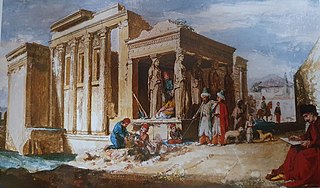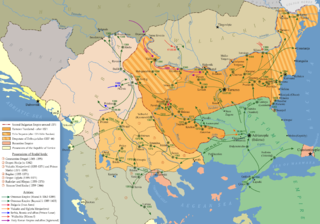Dhimmī or muʿāhid (معاهد) is a historical term for non-Muslims living in an Islamic state with legal protection. The word literally means "protected person", referring to the state's obligation under sharia to protect the individual's life, property, as well as freedom of religion, in exchange for loyalty to the state and payment of the jizya tax, in contrast to the zakat, or obligatory alms, paid by the Muslim subjects. Dhimmi were exempt from certain duties assigned specifically to Muslims if they paid the poll tax (jizya) but were otherwise equal under the laws of property, contract, and obligation.
Jizya is a tax historically levied on dhimmis, that is, protected non-Muslim subjects of a state governed by Islamic law. Quote: Jizyah: Compensation. Poll tax levied on non-Muslims, such as Jews and Christians, as a form of tribute and in exchange for an exemption from military service, based on Quran 9:29. The Quran and hadiths mention jizya without specifying its rate or amount, and the application of jizya varied in the course of Islamic history. However, scholars largely agree that early Muslim rulers adapted some of the existing systems of taxation and modified them according to Islamic religious law.

The vast majority of the territory of present-day Greece was at some point incorporated within the Ottoman Empire. The period of Ottoman rule in Greece, lasting from the mid-15th century to the successful Greek War of Independence that broke out in 1821 and the First Hellenic Republic was proclaimed in 1822, is known in Greek as Tourkokratia. Some regions, however, like the Ionian islands and various temporary Venetian possessions of the Stato da Mar were not incorporated in the Ottoman Empire. The Mani Peninsula in Peloponnese was not fully integrated into the Ottoman Empire, but was under Ottoman suzerainty.

Over the centuries of Islamic history, Muslim rulers, Islamic scholars, and ordinary Muslims have held many different attitudes towards other religions. Attitudes have varied according to time, place and circumstance.
In the Ottoman Empire, a millet was an independent court of law pertaining to "personal law" under which a confessional community was allowed to rule itself under its own laws.

The history of Ottoman Bulgaria spans nearly 500 years, beginning in the late 14th century, with the Ottoman conquest of smaller kingdoms from the disintegrating Second Bulgarian Empire. In the late 19th century, Bulgaria was liberated from the Ottoman Empire, and by the early 20th century it was declared independent.

The Ottoman Empire era of rule in Bosnia and Herzegovina and Herzegovina lasted from 1463/1482 to 1878 de facto, and until 1908 de jure.
Kosovo was part of the Ottoman Empire from 1455 to 1912, at first as part of the eyalet of Rumelia, and from 1864 as a separate Kosovo Vilayet.

The Dhimmi: Jews and Christians Under Islam is a history book on the dhimmi peoples - the non-Arab and non-Muslim communities subjected to Muslim domination after the conquest of their territories by Arabs by Bat Ye'or. The book was first published in French in 1980, and was titled Le Dhimmi : Profil de l'opprimé en Orient et en Afrique du Nord depuis la conquête Arabe. It was translated into English and published in 1985 under the name The Dhimmi: Jews and Christians Under Islam. The book provides a wealth of documents from diverse periods and regions, many of them previously unpublished and makes a clear distinction between factual history and biased interpretations, providing a comprehensive study of dhimmi populations that draws on numerous original source materials to convey an accurate portrait of their status under Islamic rule.
Forced conversion is the adoption of a religion or irreligion under duress. Someone who has been forced to convert to a different religion or irreligion may continue, covertly, to adhere to the beliefs and practices which were originally held, while outwardly behaving as a convert. Crypto-Jews, Crypto-Christians, Crypto-Muslims and Crypto-Pagans are historical examples of the latter.

Islam in Kosovo has a long-standing tradition dating back to the Ottoman conquest of the Balkans. Before the Battle of Kosovo in 1389, the entire Balkan region had been Christianized by both the Western and Eastern Roman Empire. From 1389 until 1912, Kosovo was officially governed by the Muslim Ottoman Empire and a high level of Islamization occurred among Catholic and Orthodox Albanians, mainly due to Sufi orders and socio-political opportunism. Both Christian and Muslim Albanians intermarried and some lived as "Laramans", also known as Crypto-Christians. During the time period after World War II, Kosovo was ruled by secular socialist authorities in the Socialist Federal Republic of Yugoslavia (SFRY). During that period, Kosovars became increasingly secularized. After the end of Communist period religion had a revival in Kosovo. Today, 95.6% of Kosovo's population are Muslims, most of whom are ethnic Albanians. There are also non-Albanian speaking Muslims, who define themselves as Bosniaks, Gorani and Turks.
A significant number of people in the former Kingdom of Bosnia converted to Islam after the conquest by the Ottoman Empire in the second half of the 15th century, giving it a unique character within the Balkan region. It took over one hundred years for Islam to become the majority religion. Many scholars agree that the Islamization of the Bosnian population was not violent, but was, for the most part, peaceful and voluntary.

Religion in Kosovo is separated from the state. The Constitution establishes Kosovo as a secular state that is neutral in matters of religious beliefs and where everyone is equal before the law and freedom to belief, conscience and religion is guaranteed.

In AD 1453, the city of Constantinople, the capital and last stronghold of the Byzantine Empire, fell to the Ottoman Empire. By this time Egypt had been under Muslim control for some seven centuries. Jerusalem had been conquered by the Rashidun Caliphate Muslims in 638, won back by Rome in 1099 under the First Crusade and then reconquered by Saladin's forces during the siege of Jerusalem in 1187. Later in the seventh Crusade, it was taken back by the Catholics once again. It was conquered by the Ottomans in 1517. Orthodoxy, however, was very strong in Russia which had recently acquired an autocephalous status; and thus Moscow called itself the Third Rome, as the cultural heir of Constantinople. Under Ottoman rule, the Greek Orthodox Church acquired power as an autonomous millet. The ecumenical patriarch was the religious and administrative ruler of the entire "Greek Orthodox nation", which encompassed all the Eastern Orthodox subjects of the Empire.
The Islamization of Egypt occurred after the 7th century Arab conquest of Egypt, in which the Islamic Rashidun Caliphate seized control of Egypt from the Christian Byzantine Empire. Egypt and other conquered territories in the Middle East underwent a large scale gradual conversion from Christianity to Islam, accompanied by jizya for those who refused to convert. Islam became the dominant faith by the 10th to 12th centuries, and Arabic replaced Coptic as the vernacular language and Greek as the official language.

Rūm millet, or "Roman nation", was the name of the Eastern Orthodox Christian community in the Ottoman Empire. Despite being subordinated within the Ottoman political system, the community maintained a certain internal autonomy.
The persecution of Eastern Orthodox Christians is the religious persecution which has been faced by the clergy and the adherents of the Eastern Orthodox Church. Eastern Orthodox Christians have been persecuted during various periods in the history of Christianity when they lived under the rule of non-Orthodox Christian political structures. In modern times, anti-religious political movements and regimes in some countries have held an anti-Orthodox stance.
The spread of Islam spans almost 1,400 years. The early Muslim invasions that occurred following the death of Muhammad in 632 CE led to the creation of the caliphates, colonizing a vast geographical area; conversion to Islam was boosted by Arab Muslim forces colonizing vast territories and building imperial structures over time. Most of the significant expansion occurred during the reign of the rāshidūn ("rightly-guided") caliphs from 632 to 661 CE, which were the first four successors of Muhammad. These early caliphates, coupled with Muslim economics and trading, the Islamic Golden Age, and the age of the Islamic gunpowder empires, resulted in Islam's spread outwards from Mecca towards the Indian, Atlantic, and Pacific Oceans and the creation of the Muslim world. The Islamic conquests, which culminated in the Arab empire being established across three continents, enriched the Muslim world, achieving the economic preconditions for the emergence of this institution owing to the emphasis attached to Islamic teachings. Trade played an important role in the spread of Islam in some parts of the world, such as Indonesia.
The Islamization of Albania occurred as a result of the Ottoman conquest of the region beginning in 1385. The Ottomans through their administration and military brought Islam to Albania through various policies and tax incentives, trade networks and transnational religious links. In the first few centuries of Ottoman rule, the spread of Islam in Albania was slow and mainly intensified during the seventeenth and eighteenth centuries due in part to greater Ottoman societal and military integration, geo-political factors and collapse of church structures. It was one of the most significant developments in Albanian history as Albanians in Albania went from being a largely Christian population to one that is mainly Sunni Muslim, while retaining significant ethnic Albanian Christian minorities in certain regions. The resulting situation where Sunni Islam was the largest faith in the Albanian ethnolinguistic area, but other faiths were also present in a regional patchwork, played a major influence in shaping the political development of Albania in the late Ottoman period. Apart from religious changes, conversion to Islam also brought about other social and cultural transformations that have shaped and influenced Albanians and Albanian culture.
The ethnonym Turks has been commonly used by the non-Muslim Balkan peoples to denote all Muslim settlers in the region, regardless of their ethno-linguistic background. The majority of these, however, were indeed ethnic Turks. In the Ottoman Empire, the Islamic faith was the official religion, with Muslims holding different rights from non-Muslims. Non-Muslim ethno-religious legal groups were identified by different millets ("nations").














